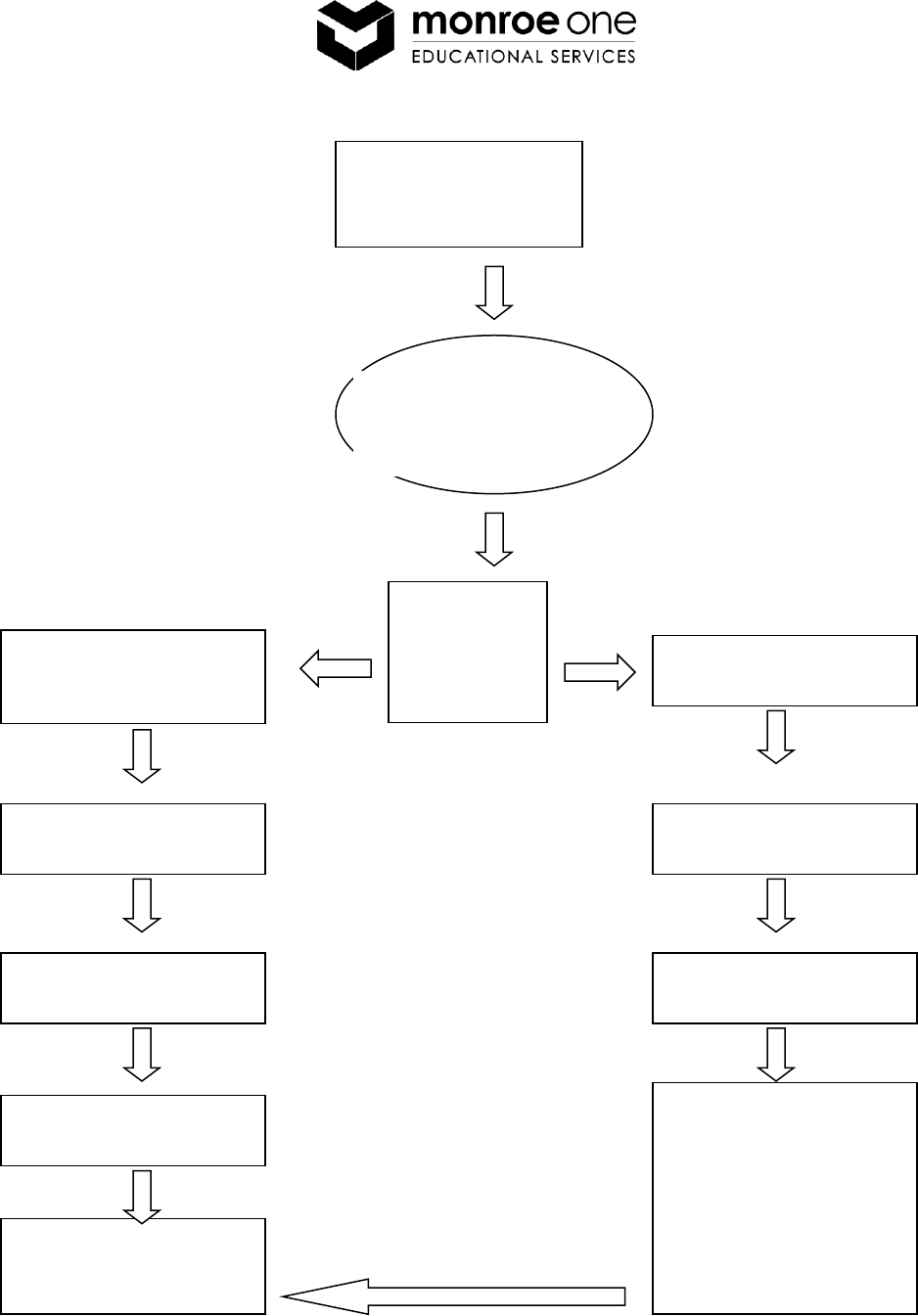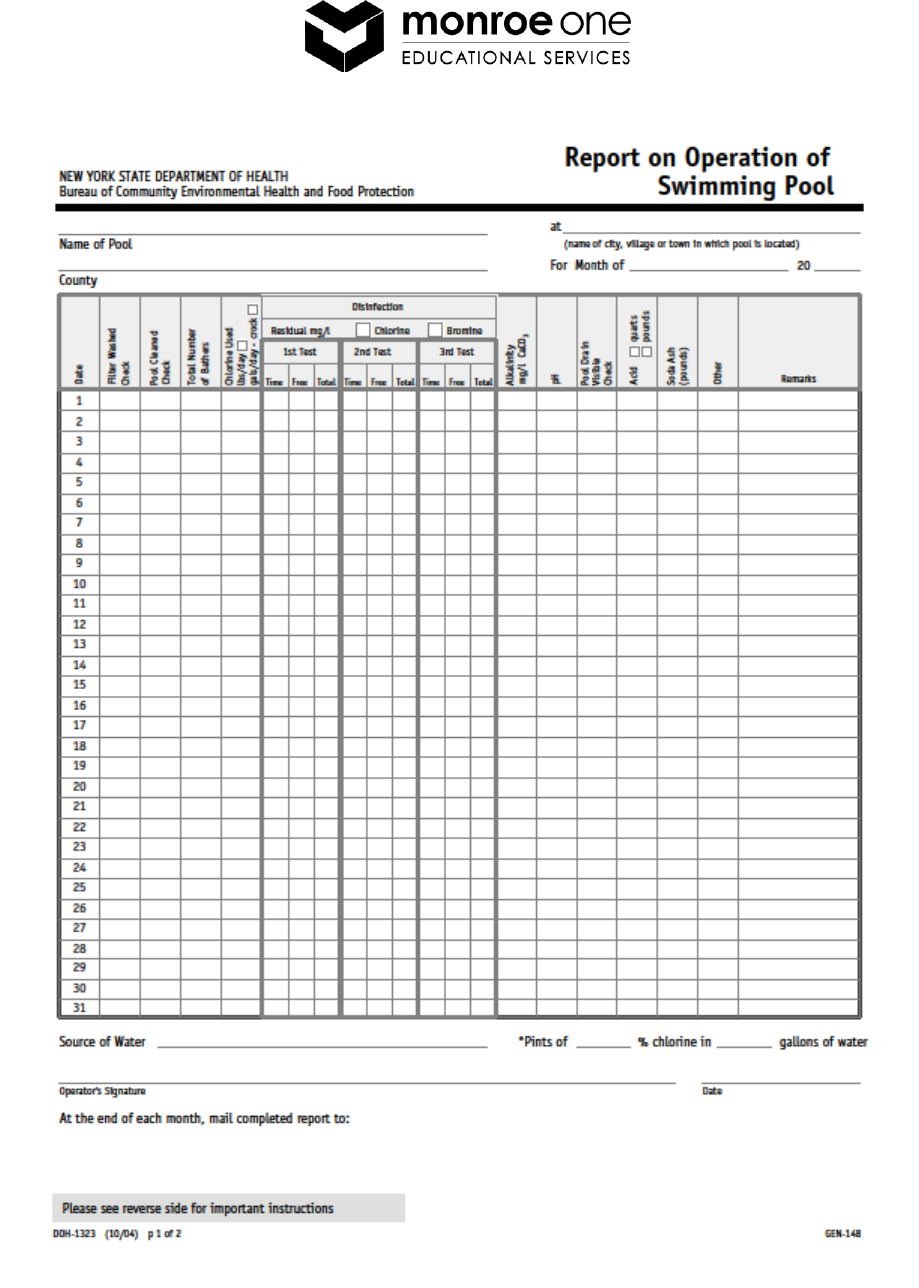
Swimming Pool
Safety and
Emergency Action Plan
Monroe One BOCES
41 O’Conner Road
Fairport, NY 14450

Swimming Pool Safety Plan 2018 -2019 Rev. 10/23/2018
2
Swimming Pool
Safety and Emergency Action Plan
Table of Contents
Introduction …………………….…….4
I. Organization and Management ……………………….…4
A. Emergency Contacts ……………………..…..4
B. Chain of Command ……………………..…..4
C. Job Duties and Descriptions …………………..……..5
II. Injury Prevention ………………..………..7
A. Daily Inspection Duties ………………………....7
B. Rules and Regulations ……………………….…8
C. Diving Safety ……………………….…9
D. Bather Capacity …………………..……..9
E. Supervision and Coverage ………………..………..9
F. Chemical Storage and Handling ……………..…………10
III. Emergency Plan …………….…..……..12
A. Communication System …………..…..……....12
B. Emergency Telephone Numbers …………………………12
C. First Aid Area …………………………13
D. Missing Person Procedure …………………………13
E. Incident Log …………………………13
F. Fecal Incidents ………………………...14
G. Medical Emergencies …………………………14
H. Epileptic Seizures …………………………15
I. Evacuation Procedure …………………………15
J. Chlorine Gas Leak …………………………15
IV. In-Service Training and Drills …………………………16
A. In-Service Training …………………………16
B. Drills …………………………16
C. Lifeguard Performance Standards …………………………17

Swimming Pool Safety Plan 2018 -2019 Rev. 10/23/2018
3
V. Swimming Pool Maintenance …………………………18
A. Treatment …………………………18
B. Water Quality …………………………18
C. Chemical Quality …………………………18
D. Cleanliness …………………………19
E. Water Problems …………………………19
F. Chemical Safety ………………………...20
G. Balanced Water (pH Factor) …………………………21
H. pH Range …………………………21
I. Normal Control Levels …………………………22
Appendices
A. Acceptable Lifeguard Certification ………………………...23
B. School Swimming Pools …………………………24
C. Safety Plan Sign Off Record …………………………25
D. Emergency Telephone List …………………………26
E. Emergency Telephone Call ………………………...27
F. Flow Chart During A Pool Incident ………………………….28
G. Swimming Pool Injury or Illness Reporting Log ……….29
H. Swimming Pool Injury Log ………………………….31
I. Swimming Pool Fecal Incident Log ………………………….32
J. Report on Operation of Swimming Pool …………………33

Swimming Pool Safety Plan 2018 -2019 Rev. 10/23/2018
4
Monroe One BOCES Swimming Pool Safety and Emergency Action Plan
Introduction
It is required by Section 6-1.23 (c) and 6-2.17 (a)(4) of the New York State Sanitary Code that
pool and beach operators develop, update and implement a written safety plan. The plan must
include procedures for reacting to emergencies, injuries and other incidents, providing first aid,
summoning help, ensuring daily bather supervision and injury prevention.
I. Organization and Management
A. Emergency Contacts
Name
Position
Office Phone
Cell Phone
E-mail Address
Shannon
Duserick
Ass’t Director of Student
Programs & Services
(585) 249-
7236
Shannon_duserick@
boces.monroe.edu
Julia
Boname
Lifeguard
(585)
383-2288
Julia_boname@
boces.monroe.edu
James
Hartman
O&M Foreman
(585)
249-7066
(585)
967-0203
James_Hartman@
boces.monroe.edu
Jim
Mulcahy
Custodial Supervisor
(585)
249-7292
(585)
857-1258
Jim_Mulcahy@
boces.monroe.edu
James
Colt
Director of Safety &
Security
(585)
383-2298
(585)
737-7915
James_Colt@
boces.monroe.edu
B. Chain of Command
Monroe One
Board of Education
District Superintendent
Assistant Superintendent for
Finance & Operations
Assistant Superintendent for
Instruction
Operations & Maintenance
Foreman
Director of Student Programs
and Services
Maintenance Staff
Ass’t Director of Student
Programs and Services
Lifeguards & Aides

Swimming Pool Safety Plan 2018 -2019 Rev. 10/23/2018
5
C. Job Duties and Descriptions
1. Board of Education
a. Establish policies governing the aquatic activities,
b. Approves employees working in the swimming pool.
2. District Superintendent
a. Implements policies of the board of education,
b. Recommends approval of all employees working in the swimming
pool.
3. Assistant Superintendent for Finance & Operations
a. Selects operations and maintenance staff for employment
recommendations,
b. Over sees operations and maintenance employees.
c. Over sees planning and provisioning for proper pool supplies and
equipment.
d. Oversees the development of Emergency Plans
4. Operations & Maintenance Foreman
a. Supervises the maintenance staff day to day operations and assigns
work.
b. Recommends changes in supplies and equipment replacement
schedules.
5. Maintenance Staff
Maintain the facility in a clean and safe condition to include:
a. Inspecting the pool each morning prior to use,
b. Brushing pool walls and vacuuming the pool bottom daily between
pool closing and pool reopening for use.
c. Test chlorine and pH four (4) times per day (7:00 am, noon 4:00 pm,
and 7:00 pm), and record results on the Health Department form.
Completed forms are either to be sent to the Health Department on
the last day of the month, or kept on file for review by the Health
Department representative.
d. Adjust the chemical feed equipment as necessary. Maintain filtrating
equipment such as the backwash filters, hair strainer basket.
e. Cleaning and supplying locker, toilet, and shower facilities.

Swimming Pool Safety Plan 2018 -2019 Rev. 10/23/2018
6
6. Assistant Superintendent for Instruction
a. Recommends instruction staff for employment, including the Director
of Student Programs and Services.
b. Over sees Pool Operation.
7. Director of Student Programs & Services
a. Recommends instruction staff for employment, including the
Assistant Director of Student Programs and Services.
b. Over sees Pool Operation.
8. Assistant Director of Student Programs & Services
a. General supervision of the swimming pool,
b. Advocate for swimming pool improvements,
c. Interviews employees who may work in the swimming pool,
d. Supervises all athletic activities and facilities within Monroe One
BOCES with the assistance of certified teachers and adjunct staff.
e. Recruits, interviews, and recommends the hiring of lifeguards and
teacher aid staff
f. Directs and supervises all personnel in the proper maintenance and
operation of the swimming pool to include:
Scheduling work hours, breaks, rotation of guards, and
posting of schedules
Coordinating fitness training and drills
Being responsible for the condition and placement of
lifesaving equipment
9. Lifeguard or Teacher Aide
Maintain a logbook of incidents
Performing teaching and lifeguard duties
Maintains proper certifications for lifeguarding and CPR
Designating and scheduling use of various swimming ability areas
Assures that all safety equipment is in its place, and in good repair
each day prior to the opening of the swimming pool
Guards the assigned areas of the swimming pool
Enforces rules and regulations
Participates in fitness drills and training
Completes written reports of incidents

Swimming Pool Safety Plan 2018 -2019 Rev. 10/23/2018
7
II. Injury Prevention
A. Daily Inspection Duties
1. Lifeguard and Aides
a. Make sure all lifesaving equipment is in good condition, and it is in the
proper place. Report any defects to the Pool Supervisor immediately so
the equipment can be either repaired or replaced
b. At a lifeguarded pool, ring buoys are not a substitute for rescue tubes.
Also the rescue tubes must stay with the lifeguard, not hung on the wall
unless these are in addition to the rescue tubes that the lifeguard(s)
carry with them.
c. The 15 foot reaching pole is to be hung on the hooks provided on the
wall space above the deck in the deep end of the pool.
d. The spine board and 24 unit first aid kit are to be at the poolside. The
first aid kit needs to be restocked as necessary.
e. The pocket mask, used in artificial respiration, is to be kept with the
first aid kit.
f. The depth markings on the edge of the pool deck must be visible. The
“No Diving” sign must be clearly posted on the pool deck or wall in
areas where the water depth is less than eight (8) feet deep.
2. Maintenance Staff
a. Underwater pool lights and other electrical circuits in the pool area –
test ground fault interrupter (GFCI) at least once a week and record
results
b. Main drain gate – to be secured to the bottom and not broken
c. Pool doors – self-closing and self-latching mechanism to be operational
d. Pool ladders – to be firmly anchored to pool walls and deck.
e. Water clarity is to be such that the main drain is clearly visible
f. Make sure the covers are on the acid and chlorine crocks, and the
labels on the crocks are clearly visible.
g. Make sure all 5-gallon chlorine containers are stored in a properly
secured area. All new deliveries are to be put away immediately.
h. Throughout the day, periodically check locker and toilet rooms for
standing water, mop as needed to eliminate slippery conditions.
i. Immediately repair any deficiencies reported by the Director of Physical
Education, the Pool Supervisor, Lifeguard or aide. If immediate repairs
are not possible, the affected areas are to be appropriately marked
against use.

Swimming Pool Safety Plan 2018 -2019 Rev. 10/23/2018
8
B. Rules and Regulations
1. The lifeguard or aide is to assure that the signs containing the rules and
regulations are posted in areas of the pool near entrances and exits. These
signs should be readable and complied with.
2. The lifeguard or aides must maintain a progressive disciplinary program:
a. First offense – speak directly with person
b. Second offenses – keep the person out of the water for a short period
of time, and speak with the person again.
c. Third offenses – speak directly with the person again and explain that
they are being denied the use of the pool for one or more days.
3. The lifeguard or aide must be familiar with the closing and emergency
closing of the swimming pool.
4. General rules to be posted:
a. No “horseplay” in the water or on the pool deck.
b. No running on the pool deck.
c. No diving
d. No glass allowed in the pool area
e. No eating in the pool area
f. No throwing of objects in the pool area
g. Additional general or health related rules may be established
5. Health rules to be posted:
a. Showers are to be taken before entering the water
b. Bathing caps may be required
c. Persons with open rashes or sores are not allowed in the facility
d. No spitting, spouting water or blowing the nose in the water
e. No urinating or defecating in the water
f. No chewing gum
g. No food, drink, or smoking in the pool area.
h. Pets are not allowed in the facility
i. Appropriate bathing attire must be worn
j. Street shoes and street clothing are not to be worn in the pool area
k. First aid equipment is to be used by authorized personnel only
l. Additional general or health related rules may be established

Swimming Pool Safety Plan 2018 -2019 Rev. 10/23/2018
9
C. Diving Safety
At its deepest depth the Monroe One BOCES Therapeutic Pool is seven feet
deep. There is no designated diving area. No diving is allowed.
D. Bather Capacity
1. The lifeguard or aide will, every half an hour, determine the actual numbers
of persons in the pool area. It should not exceed the maximum capacity
certified for the area.
2. The New York State Uniform Code of the Fire Protection requires that each
area be designated by a maximum capacity.
3. The New York State Health Department determines the maximum capacity
for a swimming pool by allowing:
a. Shallow area – fifteen (15) square feet of pool water surface area per
bather.
b. Deep area – twenty-five (25) square feet of pool water surface area per
bather.
4. The maximum number of people allowed in the facility at any one time is 72.
5. A sign shall be posted in the pool area stating:
a. The maximum numbers of bathers who may use the swimming pool at
one time.
b. The hours that the swimming pool is open.
c. That pool use is prohibited at any other time.
d. Swimming is not allowed when pool is closed.
e. Swimming is prohibited when you cannot easily see the bottom drain
due to turbid water.
f. If bottom drain grate is loose or missing or if the pool water PH and or
chlorine is out of swimming range, swimming is also prohibited.
E. Supervision and Coverage
1. The Life Guard & Aid projects the number of guards or aides needed based
upon the anticipated swimmer load and considering if this facility has:
Swimming with other schools or groups,
Other groups of swimmers using this pool,
Open swim besides the student use,
Other activities that would require more or different supervision or use
of first aide equipment.
2. Elevated lifeguard chairs shall be provided at all pools having a pool water
surface area greater than 2,000 square feet. For each additional 2,000
square feet, one lifeguard chair shall be provided. The chairs shall be
located so as to provide a clear, unobstructed view of the pool bottom in

Swimming Pool Safety Plan 2018 -2019 Rev. 10/23/2018
10
the area under surveillance and be in compliance with the New York State
Health Department. Each chair is to be equipped with a rescue tube with 6
feet of rope and a whistle.
3. The swimming area will be divided into sections based on swimmer need or
ability. All sections will have sufficient lifeguard coverage.
4. There should be one roving lifeguard who covers those areas of the water
that are blind to the lifeguards who cover sections of water from a
stationary position.
5. Lifeguards should provide a great degree of visual surveillance. They should
scan their area of responsibility; they should scan small overlapping
adjacent area.
6. In emergency situations, when there are two or more lifeguards on duty,
and one lifeguard must enter the water, each lifeguard who remains out of
the water will have a larger area of responsibility to supervise. It will be
necessary for the lifeguards remaining out of the water to move to a better
vantage point, or to begin making swimmers leave the water.
7. Lifeguards will be provided with a 15-minute break each hour. At this time,
a rotation of stations will be done.
8. The lifeguards must not engage in activities that will interfere with the
supervision of swimmers.
F. Chemical Storage and Handling
Good safety habits and proper handling of chemicals are essential for accident
prevention. The following general rules should be taken into consideration when
storing and handling swimming pool chemicals.
1. Maintain good housekeeping standards
2. Store all pool chemicals in a cool, dry, well ventilated area
3. Remove any damaged products from the shelf immediately.
4. Keep clean, clear, plastic bags and a suitable container available in the
event of a spill or emergency
5. Notify Environmental Health and Safety of any potential emergency
situation
6. Keep spilled material dry and prevent mixing with other materials
7. Use only water to extinguish chlorine fires
8. Rotate inventory on a first in, first out basis
9. Store chemicals on pallets or shelving at all times

Swimming Pool Safety Plan 2018 -2019 Rev. 10/23/2018
11
DO NOT –
1. Do not store liquid chemicals above solids
2. Do not smoke where pool chemicals are stored or handled
3. Do not place spilled material back into the original container
4. Do not allow chlorine to become damp or wet
5. Do not dispose of spilled material in trash or waste containers
6. Do not use dry powered fire extinguishers
7. Do not mix pool chemicals together
8. Do not allow chlorinated material into the sewer
9. Do not store chemicals near incompatible materials such as oils, grease, or
flammable materials
Individuals responsible for the use and storage of chemicals must exercise
extreme caution to prevent injury:
1. NEVER add water to chemicals; always add chemicals to water slowly
2. NEVER pour from an unlabeled container
3. ALWAYS check the labels carefully before you pour
4. ALWAYS keep chemicals in their original containers

Swimming Pool Safety Plan 2018 -2019 Rev. 10/23/2018
12
III. Emergency Plan
A. Communication System
1. Whistle Signals
1 short blast to get attention of swimmer
2 short blasts to get attention of another guard
3 short blasts EMERGENCY – guard leaving station
Long Blast to clear the water
2. Air Horn: 1 long blast EMERGENCY person in charge to respond
B. Emergency Telephone Numbers
1. Telephones for emergency purposes are located in the pool office. All
lifeguards or aides must be aware of their location.
2. Telephone numbers for the following are posted at the pool office
telephone
a. Local ambulance
b. Fire department
c. Police department
d. Poison Control Center
e. Monroe One BOCES Safety and Security Office
f. Monroe One BOCES Nurse’s Office
3. A checklist of information to provide when telephoning for emergency
assistance:
a. Name of caller
b. Location of facility
c. Telephone number of facility
d. Type of incident (drowning, cardiac arrest, chlorine gas, etc)
e. Required assistance (ambulance, fire, police)
f. Approach route
g. Advise that someone will be waiting outside to meet them
h. Before hanging up – ask if further information is needed.
C. First Aid Area
If it is not reasonable to provide first aid on the pool deck, then the first aid area is
the pool office. If the injured person is mobile, the nurse’s office is in M-2 of
Creekside School. If the injury is not mobile, then 911 must be called and an
ambulance must be summoned.

Swimming Pool Safety Plan 2018 -2019 Rev. 10/23/2018
13
D. Missing Person Procedure
1. A predetermined signal should be given to alert staff when a person is
reported missing (3 short blasts of a whistle)
2. All available staff not on duty should report to the office or to the deck right
outside the pool office door.
3. The person reporting the missing individual should give a complete
description of the missing person such as sex, height, color of hair, color of
skin, weight, and clothing. The person should remain at the office for future
identification of the missing person
4. The swimming pool should be cleared of all swimmers. The swimmers should
be required to sit on the deck around the pool and remain quiet (1 long blast
of the air horn).
5. The bottom of the pool, which should be visible, should be scanned for the
missing person. The rest room facilities, locker rooms, and showers should
also be checked
6. If the missing person can not be found in the above areas, further checking in
other areas of the school should be done until the missing person is found.
E. Incident Log
1. A written report is to be completed by the Pool Supervisor or the supervising
lifeguard immediately following an incident. Specify the times, actions taken
by various individuals, any witness statements, and equipment used.
2. A full report of any injury or illness incident occurring at a swimming pool
shall be reported by the Pool Supervisor to the Monroe County Health
Department within 24 hours of its occurrence, and a notation recorded in the
incident log book. This shall include all incidents occurring at the swimming
pool which:
Results in death
Requires resuscitation
Requires referral to a hospital or other facility for medical attention
The bather’s illness or injury may be associated with bathing water
quality.

Swimming Pool Safety Plan 2018 -2019 Rev. 10/23/2018
14
F. Fecal Incidents
1. For both formed-stool and diarrheal fecal incidents, CLOSE THE POOL
IMMEDIATELY and do not allow anyone to enter until the following
disinfection process is complete.
2. Formed-stool Incident:
a. Remove as much fecal material as possible with a net or a bucket.
Dispose of the fecal material in a sanitary manner. Disinfect the net or
bucket used – this could mean leaving it immersed in the pool. Do
NOT vacuum the stool from the pool.
b. Raise the free chlorine to 2 ppm with a water pH of 7.5 or less and a
water temperature of 77
o
F or higher. Ensure the filtration system is
full operation. Maintain these water conditions for not less than 25
minutes before reopening the pool.
3. Diarrheal Incident:
a. Raise the free chlorine concentration to 20 ppm with a water pH of
7.5 or less and a water temperature of 77
o
F or higher. Ensure the
filtration system is full operation. Maintain these water conditions
for not less than 13 hours before reopening the pool. OR, if raising
the free chlorine concentration beyond 10 ppm is difficult, or beyond
testing equipment on hand, then assume 10 ppm is the concentration
and maintain the conditions for 26 hours before reopening the pool.
b. Backwash the filter, discharging the effluent directly to waste. Do
NOT return effluent to the filter.
4. Document all fecal incidents on the FECAL INCIDENT LOG, copy of which is in
the appendices.
G. Medical Emergencies
Any medical emergencies such as a heart attack, convulsions or stroke should be
handled in the following manner:
1. If it occurs in the water, and the person has to be assisted from the water,
they should be referred to the hospital or other medical facility by
ambulance or parent.
2. If it occurs while the person is on the deck, the person should not be allowed
to remain in the pool area and should not be allowed to enter the water. The
person should be referred to the hospital or other medical facility by
ambulance or parent.
3. The situation should be documented in the Incident Log Book and reported
to the Monroe County Health Department within 24 hours.
4. Health Department after hours 753-5057.Medical Examiner 753-5905.
Medical Examiner will reach the Health Department officer who is on call.

Swimming Pool Safety Plan 2018 -2019 Rev. 10/23/2018
15
H. Epileptic Seizures
1. If it occurs in the water an effort should be made to support the victim so
that his or her head and face remain above the water with the head tilted
back to provide a clear airway.
2. Keep the victim away from the sides of the pool or deck to avoid an injury
that could be caused by uncontrolled arm and leg movements. Flotation
devices can be used to assist in this situation.
3. The victim should be removed from the water after the seizure has been
completed.
4. The victim should be referred to the hospital or other medical facility by
ambulance or parent.
Any person suffering a seizure in the pool water and submerges should be
transported to a medical facility regardless of apparent recover. A person suffering a
seizure should not be allowed in the water again for the remainder of the day.
I. Evacuation Procedure
The Evacuation Procedure will be posted in a red frame on a wall in the pool and
also by the boys and girls locker rooms. The Evacuation Procedure shall be part of
the orientation of each new group of swimmers throughout the year. The Pool
Supervisor or lifeguard on duty shall be in charge of the procedure as follows:
1. Swimmers at the shallow end of the pool shall line up at the front door
leading into the lobby (southeast corner of the pool).
2. Swimmers at the deep end of the pool shall line up at the rear exit door
leading outside to the parking lot (northwest corner of the pool).
3. Swimmers in the locker rooms shall line up at the Lobby entrance door.
4. At least one adult will accompany each group of swimmers. Everyone shall
remain by the designated doors until the lifeguard indicated the drill is over.
J. Chlorine Gas Leaks
Chlorine gas can be produced when liquid chlorine and an acid are mixed. It is an
extremely hazardous substance that can cause injuries or death in humans. Chlorine
gas is heavier than air and stays at or near ground level.
In the event of a spill or leak involving chlorine gas the following steps should be
taken:
1. Immediately evacuate the pool area following the evacuation procedure and
move at least 50 feet from the building.
2. Call the Fire Department – using posted procedures.

Swimming Pool Safety Plan 2018 -2019 Rev. 10/23/2018
16
IV. In-Service Training and Drills
A. In-Service Training
It is the responsibility of the Director of Special Education or the Pool Supervisor to plan
regularly scheduled sessions to review aspects of lifeguard principals and practices.
These training sessions should be mandatory for all personnel who carry out the duties
of a lifeguard in the pool area.
1. Review general lifesaving skills in the water.
2. Practice removals from the water for a person who may or may not be
injured. Use of the spine board for possible back or neck injury should be
practiced.
3. Practice artificial respiration on a person while in the water. Use of the
rescue buoy to accomplish this skill.
4. Knowledge and use of all rescue equipment required in the swimming pool
should be demonstrable by each lifeguard.
5. Review first aid skills and cardiopulmonary resuscitation.
6. Review preventative lifeguarding skills and procedures.
7. Review all emergency procedures. Emergency action plans should include
but not be limited to:
a. Victim recognition – distress situations or drowning situations
b. Individual assignments
c. Emergency calls and signals
d. Back up systems
e. Records and reports
B. Drills
The Assistant Director of Student Programs & Services will, on a monthly basis, present
to the aquatic staff an emergency situation to be role played. The actions and
outcomes will be evaluated, reviewed, and constructive criticism made of the event.

Swimming Pool Safety Plan 2018 -2019 Rev. 10/23/2018
17
C. Lifeguard Performance Standards
SKILL
TIME
1. Recover a 10 pound object in 10 foot depth of
water with a 30 foot approach and surface dive
10 seconds or less
2. Tow a 10 pound object 50 yards using the
inverted breaststroke kick
1 minute 15 seconds or less
3. Tow a 10 pound object 50 yards using the
scissor kick
1 minute 15 seconds or less
4. Swim 50 yards freestyle
35 seconds or less
5. Swim 500 yards American Crawl
10 minutes or less
6. Tread water while supporting a 10 pound
object in both hands
2 minutes
7. Float in a supine position motionless
2 minutes

Swimming Pool Safety Plan 2018 -2019 Rev. 10/23/2018
18
V. Swimming Pool Maintenance
Persons who are responsible for the proper operation of the maintenance of the filtration
and disinfection equipment at swimming pools must have technical knowledge of water
chemistry. This knowledge should include thorough understanding of disinfectants; the
methods of testing and controlling the chemical balance of water, including pH level and the
turbidity; the physical and biological properties of water; and the bacteriological standards
that are established for the facility.
A. Treatment
All swimming pools shall be equipped with a recirculation system which includes
filtration and disinfection facilities to provide water quality consistent with the
bacteriological chemical and physical standards.
B. Water Quality
1. Sample Collection Analysis: Microbiological samples shall be collected from
swimming pools when determined by the permit issuing official to be
necessary to evaluate water quality and be examined in laboratories
approved by the New York State Health Department.
2. Microbiological Quality: Coliform bacteria levels should not exceed 4 parts
per 100 milliliters in more than one sample examined each month. When the
membrane filter technique is used; or when the fermentation tube method is
used, coliform bacteria shall not be present in more than 10% of portions
analyzed in any month; also, total bacteria shall not exceed 200 parts per
milliliter.
C. Chemical Quality
1. The chemical quality of the water in the pool shall not cause irritation to the
eyes or skin of the swimmers or have other objectionable physiological
effects on swimmers.
2. The total alkalinity of the pool water shall be maintained within the range of
80 – 120 mg/l.
3. The pool water shall be chemically balanced. The Monroe County Health
Department official may determine the saturation index monthly or any
other frequency required to maintain pool clarity, proper disinfection,
alkalinity, and pH levels.

Swimming Pool Safety Plan 2018 -2019 Rev. 10/23/2018
19
D. Cleanliness
1. The bottom and sidewalls of the swimming pool shall be kept free of
sediment and visible soil, and the pool water surface shall be kept free of
visible floating matter.
2. The water in the swimming pool shall be sufficiently clear to permit a white
and black object four inches in diameter, placed at any location at the
bottom of the swimming pool to be clearly visible from the side of the
swimming pool at all times.
3. Recommendation for Swimming Pool Conditions
4. Bacteria – no coliforms
5. Air temperature – 5 – 10 degrees higher than water temperature
6. Chemical levels – balanced to provide healthful environment
7. Turbidity – sparkling water, bottom visible from anywhere on the deck
8. Water color – blue
9. Pool bottom – vacuumed and free of dirt and other materials, such as hair
10. Dissolved solids – less than 200 parts per million
11. Decks – clean; free of stagnant water and algae; not slippery
E. Water Problems
PROBLEM
CAUSES
Turbidity
(cloudy water)
Low disinfectant residual
Tear in DE filter cover
Water level below gutters or skimmer when pool
not in use
Filters need cleaning
Precipitate from pH above 7.8
Algae
Low Disinfectant residual
Using a disinfectant ineffective against algae
Having a pH above 7.8
Water too warm
Colored Water
Water not balanced
Green – high copper or iron compound content
Red or reddish brown – high iron content (rust)
Brown or black – high manganese content
Eye Irritation
Having a low pH – below 7.0
Having a high pH – above 8.4
High level or chloramines (chlorine and ammonia
compounds)
Chlorine Odor
Low chlorine content in the water
Chlorine and ammonia forming chloramines

Swimming Pool Safety Plan 2018 -2019 Rev. 10/23/2018
20
F. Chemical Safety
CHEMICAL
PROBLEMS
Chlorine Gas
Leakage could necessitate evacuation of pool, and
surrounding area
Inhaled fumes can easily cause death
Chlorine gas is heavier than air, stays at or near
ground level
Calcium Hypochlorite
Lithium Hypochlorite
Some types are explosive and flammable when
contacted by organic substances such as paper, oil
and gasoline; there should be NO SMOKING around
these chemicals
Used improperly, can cause water to become
cloudy
Can be fatal if swallowed
Can cause severe burns if they get into eyes
Chlorine gas is created while burning
Sodium Hypochlorite
Contact with the skin may cause irritation
Inhaled fumes can damage lung tissue
Can cause severe burns if it gets into eyes
Bromine (organic)
Flammable and explosive; prevent contact with
organic materials, NO SMOKING around this
chemical
Test kit Reagents
(general)
Harmful or fatal if swallowed
Harmful to eyes if contacted
Ortho-Tolidine (reagent used for chlorine tests) is
carcinogenic (cancer causing)
Wash hands after using

Swimming Pool Safety Plan 2018 -2019 Rev. 10/23/2018
21
G. Balance Water (pH Factor)
The single most significant aspect of balanced water is the pH factor. The pH indicates
how basic or acidic the pool water is on a scale of 0 – 14. The number 7.0 represents
neutral – neither acidic nor basic. Water ranging from 0 – 6.9 is acidic and water ranging
from 7.1 – 14 is basic.
A pH level below 7.0 prohibits flocculation, which removes suspended materials from
the water, and the proper functioning of sand filters. It can cause corrosion of plumbing,
filter tanks, and the heater as well as cause discomfort to the eyes, skin, and mucous
membranes. A pH of 7.8 or above reduces the effectiveness of halogen disinfectants
(chlorine, bromine, iodine), allows for calcification in sand filters and pool heaters,
promotes growth of algae, and causes irritation to the eyes. Attention to the proper pH
and other chemical levels will provide for safer operation, more comfortable swimming,
and longer pool life.
H. pH Range
ACIDIC
0.0
1.0
2.0
3.0
4.0
5.0
6.0
6.9
May cause skin and eye irritation
Neutral
7.0
BASIC
7.1
7.4
7.8
8.0
9.0
10.0
11.0
12.0
13.0
14.0
Acceptable range of water
May cause skin and eye irritation

Swimming Pool Safety Plan 2018 -2019 Rev. 10/23/2018
22
K. Normal Control Levels
pH
7.4 – 7.8
Temperature
85 – 90 degrees F
Free Chlorine
0.6 minimum
Saturation index
-0.5 to +0.5
Calcium Hardness
180 – 250 mg/liter

Swimming Pool Safety Plan 2018 -2019 Rev. 10/23/2018
23

Swimming Pool Safety Plan 2018 -2019 Rev. 10/23/2018
24

Swimming Pool Safety Plan 2018 -2019 Rev. 10/23/2018
25
SWIMMING POOL SAFETY AND EMERGENCY ACTION PLAN
LIFEGUARDS AND STAFF
SIGN OFF RECORD
I, _________________________________________________
(name)
Have read the Monroe One BOCES Swimming Pool Safety and Emergency Plan in its
entirety, understand it contents, and agree to follow all of the safety rules to the best of
my ability.
Signature: ________________________________
Position/ Title: ________________________________
Date: ________________________________

Swimming Pool Safety Plan 2018 -2019 Rev. 10/23/2018
26
EMERGENCY TELEPHONE NUMBER LIST
This notice is to be posted at each telephone in the swimming pool area.
LOCAL AMBULANCE – 911
FIRE DEPARTMENT – 911
POLICE DEPARTMENT – 911
Poison Control Center – (585) 275-3232
Monroe One BOCES Safety and Security
x 2298
Safety and Security (After School Hours)
(585) 329-0836
Monroe One BOCES Nurse’s Office
x 6416

Swimming Pool Safety Plan 2018 -2019 Rev. 10/23/2018
27
EMERGENCY TELEPHONE CALL INSTRUCTIONS
The following information must be provided when telephoning for emergency assistance
Name of Caller
Location of Facility – Monroe One BOCES Pool address is 41 O’Connor Road, Fairport and
Is a separate building, next to the main building, east of the main parking
lot.
Telephone Number – (585) 383-2288
Type of Incident – (drowning, cardiac arrest, chlorine gas, etc.)
Required Assistance – (ambulance, fire, police)
Approach Route – enter at the covered sidewalk on the south side of the building
Advise that someone will be waiting outside.
**DO NOT HANG UP THE PHONE UNTIL YOU ARE TOLD TO DO SO.
Ask if there is any further information that is needed.

Swimming Pool Safety Plan 2018 -2019 Rev. 10/23/2018
28
POOL INCIDENT FLOW CHART
Lifeguard approaches
victim while at the
same time…..
Lifeguard calls for
an assistant and
clears pool
Lifeguard
rescues
victim and
provides FA
Emergency Medical
Technicians summoned
by assistant
No further first aid is
needed
EMT personnel take
over
Notification of family
and chain of command
Incident report
completed
County Health
Department notified
within 24 hours
Notification of family
and chain of command
Incident report
completed
If CPR was provided or
if outside medical
attention was required or
if poor water quality
was a factor or if death
resulted, then…

Swimming Pool Safety Plan 2018 -2019 Rev. 10/23/2018
29
Monroe County Health Department
Water Supply and Pool Section
Swimming Pool Injury or Illness Reporting Log
Pool Name: ________________________ Date: _________________
Lifeguard on Duty: ________________________ Telephone: _____________
Victim’s Name: ________________________ Telephone: _____________
Address:
________________________________________________________________________
Guardian’s Name: _________________________ Telephone: _____________
Address:
________________________________________________________________________
Victim’s Age: ______ Male: _____ Female: _____
Describe the incident and treatment given:
______________________________________________________________________________
______________________________________________________________________________
______________________________________________________________________________
______________________________________________________________________________
______________________________________________________________________________
______________________________________________________________________________
______________________________________________________________________________
______________________________________________________________________________
______________________________________________________________________________
______________________________________________________________________________
______________________________________________________________________________
______________________________________________________________________________
______________________________________________________________________________
______________________________________________________________________________
______________________________________________________________________________
Time and date of incident: ____________________________________________________

Swimming Pool Safety Plan 2018 -2019 Rev. 10/23/2018
30
Names and phone numbers of witnesses:
______________________________________________________________________________
______________________________________________________________________________
______________________________________________________________________________
If any of the following occurred, call the Health Department within 24 hours at 274-6057. After
hours and weekends call 274-7100, and complete the information below:
1. If CPR was given
2. If death occurred
3. If the victim received professional medical attention in addition to lifeguard first aid
4. If the pool water gave the illness or injury, (for example, the pH was too low and gave
skin burns)
If applicable:
Name and telephone number of hospital or clinic where the victim went:
______________________________________________________________________________
______________________________________________________________________________
______________________________________________________________________________
______________________________________________________________________________
______________________________________________________________________________
Name and phone number of emergency medical technicians, police, or fire personnel in
attendance:
______________________________________________________________________________
______________________________________________________________________________
______________________________________________________________________________
______________________________________________________________________________
______________________________________________________________________________
______________________________________________________________________________
Any other comments:
______________________________________________________________________________
______________________________________________________________________________
______________________________________________________________________________
______________________________________________________________________________
______________________________________________________________________________
______________________________________________________________________________

Swimming Pool Safety Plan 2018 -2019 Rev. 10/23/2018
31
Swimming Pool Injury Log
Date
Time
Name and Address
Age
Nature of
Incident
Location
Actions Taken

Swimming Pool Safety Plan 2018 -2019 Rev. 10/23/2018
32
Swimming Pool Fecal Incident Log
Date:
Time:
Incident type:
Formed Stool
Diarrheal
Staff Present:
Swimmers in swimming pool water at time of incident:
(use back of page if more room is needed)
Disinfection Response:
Free Chlorine level Achieved:
Time Target Free Chlorine Level Achieved:
Time Backwash completed:
Date and Time Pool Reopened to Swimmers:

Swimming Pool Safety Plan 2018 -2019 Rev. 10/23/2018
33

Swimming Pool Safety Plan 2018 -2019 Rev. 10/23/2018
34
